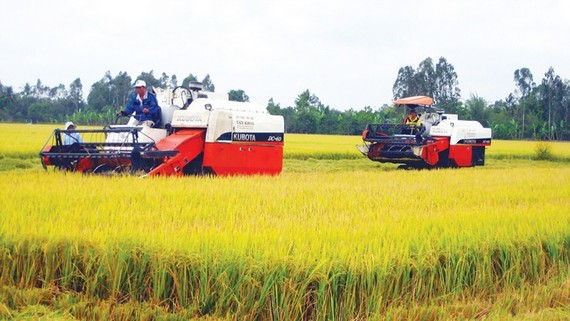
In early August this year, the EU-Vietnam Free Trade Agreement (EVFTA) officially took effect. This is a door that opens up many opportunities for Vietnamese enterprises to export to the EU market. Accordingly, Vietnam's rice products will be exempt from export tariffs to the EU, of which, 80,000 tons of rice will enjoy tax incentives. In the Mekong Delta, Trung An Company in Can Tho City is one of the exporters in the fragrant and high-quality rice segment to fastidious markets.
The EVFTA is a rare opportunity for Vietnamese rice exporters. In the past many years, the company has associated with farmers to cultivate around 7,000 hectares of rice or around 150,000 tons of rice under safe procedures, meeting choosy markets, said Mr. Pham Thai Binh, Director of Trung An Company.
This year, the company will strive to reach an export of 80,000 tons of high-quality fragrant rice. The current export price of fragrant rice of Trung An is the dream of many enterprises when reaching an average price of US$700-$900 per ton, of which, the price of rice exported to Germany, France, Switzerland, and the US is the highest, up to $1,500 per ton.
Currently, the paddy prices in the Mekong Delta are stable at a high level, with regular paddy fetching over VND5,000 per kilogram and high-quality paddy over VND6,000 per kilogram. However, the price of rice in the country has increased sharply in recent weeks because traders are hoarding their goods. In the first seven months of this year, Vietnam exported nearly 3.9 million tons of rice, worth $1.9 billion, up 10.9 percent in value over the same period last year. It is forecasted that Vietnam will outdo Thailand to rise to the position of the top rice exporter in the world right in this year.
According to Mr. Pham Thai Binh, Trung An Company is making every effort to implement the rice production chain following advanced food safety procedures to meet the demand from demanding markets. The company does not need preferential policies, but only needs a mechanism for enterprises to access bank loans and expand the production scale from 7,000 hectares at present to about 20,000 hectares in the next few years.
Besides traditional markets, Vietnamese rice is having an opportunity to access more widely the EU market when the EVFTA came into effect. However, according to some enterprises, Vietnamese rice is rarely available in supermarkets in the EU. Thai and Cambodian rice products are still dominant in this market. Vietnam's rice quality has now been improved. However, according to a rice exporter in the Mekong Delta, the main weaknesses of Vietnamese rice are poor brand promotion, unstable production process, and an unstable supply of high-quality rice.
According to Mr. Ho Quang Cua, who has the merit of breeding the ST rice varieties, since ST25 rice won the world's best rice award, the trend of using branded rice in Vietnam has increased, and the possibility of exporting safe rice to the US market has become easier. Currently, ST24 and ST25 rice varieties have had a suitable transformation to cope with saltwater intrusion. ST24 and ST25 rice varieties are currently the wise choices of thousands of farmers in the Ca Mau peninsula. Mr. Truong Van Chet, a farmer in Nga Nam Town in Soc Trang Province, planted 1 hectare of ST24 rice variety under organic farming standards. Besides reducing costs by VND2.5 million - VND3.6 million per hectare, depending on the season, organic farming helps the soil to be improved well and the rice seeds to be bright, firm, and full. Especially, the consumption of rice is stable as enterprises are consuming the output after harvest.
In the domestic market, the prices of ST25 and ST24 rice varieties are at VND30,000 per kilogram, equivalent to over $1,300 per ton. The quality of ST24 and ST25 rice has been confirmed. This will be a turning point for the Vietnamese rice brand to solidify itself in the world market if the raw material areas can be built, attached to safe production processes. Mr. Ho Quang Cua proposed that they need to build an ST fragrant rice cultivation area in the rice-shrimp farming area of the entire Ca Mau peninsula. This will be a famous area on the world rice production map. The basis of this is the ability to easily export safe rice to the US and European markets. They proposed the safe production of fragrant rice in this rice-shrimp area and the rice production programs here, they will try to limit the use of chemicals.
Many opportunities are opening up to Vietnamese rice, the problem is that local authorities need to have policies to support the connection between enterprises and farmers, creating a "well-known rice region on the world map", like the desire of Mr. Ho Quang Cua.
























